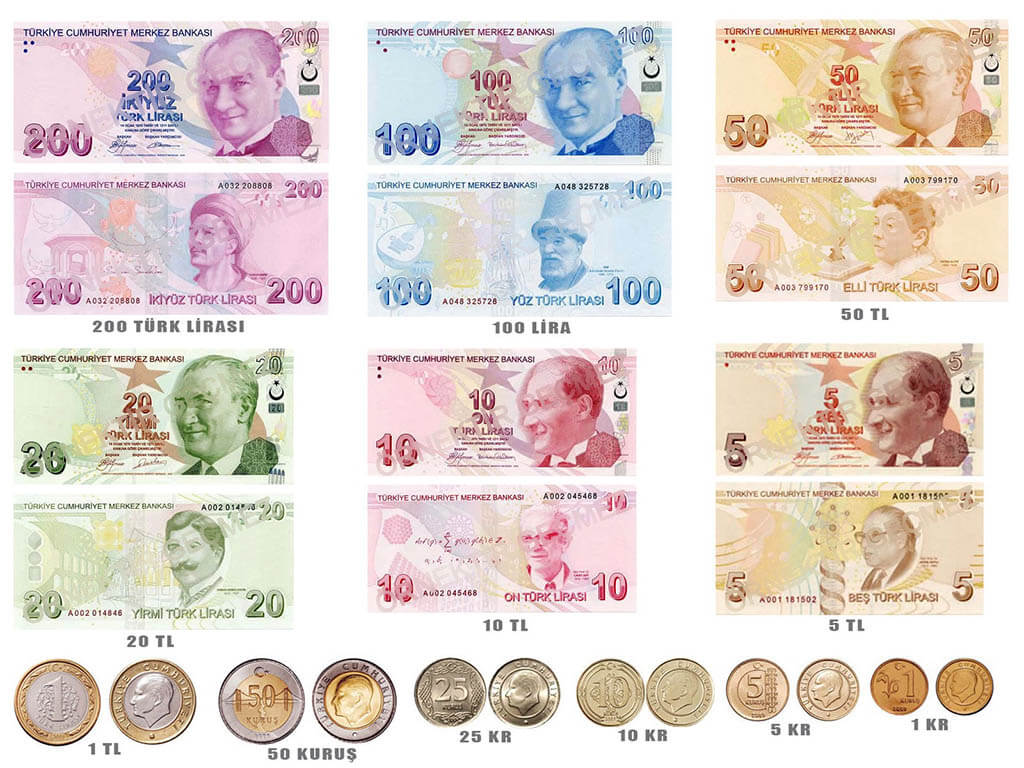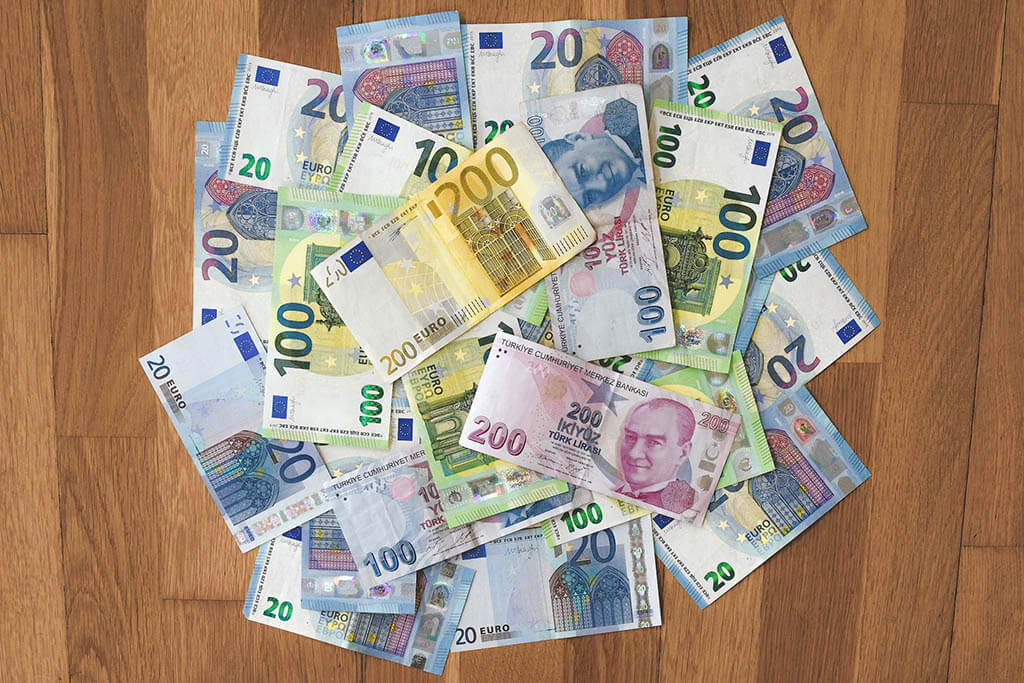Turkey’s Currency: Understanding the Lira
Table of Contents
ToggleTurkey’s official currency is the Turkish lira, abbreviated as TRY or simply TL. It has been in circulation since 1923, when it replaced the Ottoman lira. The currency is controlled by the Central Bank of the Republic of Turkey and is issued in banknotes and coins.
The lira is available in denominations ranging from 5 to 200 Turkish liras, with coins available in values from 1 kuruş to 10 Turkish liras. The Turkish lira has seen its fair share of ups and downs over time, with periods of stability followed by periods of volatility.
In recent years, inflation and political instability have contributed to fluctuations in the value of the currency. As such, understanding the current state of the Turkish lira is crucial for anyone planning to travel or invest in Turkey.
Importance of Understanding the Currency for Travelers and Investors
For travelers, understanding Turkey’s currency can make a big difference when it comes to budgeting and making purchases.
Knowing how much your money is worth compared to Turkish liras can help you avoid overspending or being taken advantage of by merchants who may try to charge you more than they should. Additionally, knowing where to exchange money can save you a lot on fees and rates.
For investors, keeping an eye on fluctuations in the value of the Turkish lira can be important when making decisions about buying or selling investments denominated in this currency.
Changes in interest rates or government policies can quickly impact its value versus other currencies such as USD or EUR.
Understanding Turkey’s currency – its history, current state, unique features is essential for anyone traveling or investing within its borders.
It will help travelers make informed decisions about spending their money wisely while ensuring that investors stay up-to-date on the latest trends and shifts in the currency market. In the next section, we will take a closer look at the history of Turkish currency.
The Evolution of Turkish Currency: From Barter to Lira
Like many ancient civilizations, Turkey used a barter system for trade as early as 1200 BC. In the 6th century BC, the Lydians were the first to introduce coins made of electrum, an alloy of gold and silver. Later on, other materials like bronze and copper were also used to make coins in various shapes.
During Ottoman rule, coins called akçe were prevalent. They were made of copper or brass and had Arabic inscriptions on them.
One akçe was worth about one-sixteenth of an Ottoman silver coin called a kuruş. The Turkish lira was introduced in 1923 after the establishment of the Turkish Republic.
At that time, it was equal in value to the French franc and was pegged at a rate of 1 lira = 100 kurus. The lira had banknotes ranging from 1 lira up to 1000 liras and coins ranging from 1 kurus up to 50 kurus.
Major Changes and Reforms Over Time
Inflation has been a significant problem for Turkey’s currency over the years. In response, Turkey has undergone several currency reforms aimed at controlling inflation levels:
- The First Lira Revaluation (1946): due to hyperinflation caused by world war II, Turkey introduced a new currency with six zeros removed from its previous value.
- The Second Lira Revaluation (1960): another significant devaluation occurred due to high inflation caused by increased military spending.
- The New Lira (2005): A new version of the Turkish lira was introduced with six zeros removed from its value. The new lira was equivalent to 1,000,000 old Turkish liras.
The Current Lira (2018): Turkey eliminated the word “new” from its currency name and began issuing a new series of banknotes and coins in honor of the country’s founder, Mustafa Kemal Ataturk.
| Year and 1$ | Lira for 1 dollar |
| 1970 | 11,30 ₺ |
| 1975 | 14,40 ₺ |
| 1980 | 80,00 ₺ |
| 1985 | 500,00 ₺ |
| 1990 | 2.500,00 ₺ |
| 1995 | 43.000,00 ₺ |
| 2000 | 620.000,00 ₺ |
| 2005 | 1.350,000 ₺ |
| 2023 | 19.5 ₺ |
Despite these reforms, inflation continues to be a challenge for Turkey’s currency. In recent years, political instability and conflicts have also contributed to fluctuations in the currency’s value.
However, Turkey remains a popular tourist destination and an emerging market economy with growth potential.
Current State of the Turkish Lira
Value Compared to Other Currencies
The Turkish lira has experienced a significant decline in value in recent years, particularly when compared to major currencies such as the US dollar and the euro.
In 2017, one US dollar was worth approximately 3.5 lira; by August 2021, that same dollar was worth more than 8 lira (and now it’s 19.5). The euro has also seen a similar increase in value against the lira during this time period.
Factors Affecting Its Value, Including Inflation and Political Instability
One major factor affecting the value of the Turkish lira is inflation. Turkey has been facing high rates of inflation for several years, with prices for goods and services increasing rapidly.
This leads to a decrease in purchasing power for individuals using the currency and can cause investors to lose confidence in its stability.
Political instability is another factor that can affect the value of a currency. In Turkey’s case, there have been several events over recent years that have caused uncertainty among investors and traders – including political turmoil, tensions with neighboring countries, and economic policies that some experts have criticized.
Recent Fluctuations in Value and Their Impact on the Economy
The fluctuations in value of Turkish lira have had a significant impact on Turkey’s economy as a whole.
When the currency depreciates rapidly against other currencies, it often leads to higher prices for imported goods – which can put pressure on businesses and households alike.
| Turkish lira exchange rate to the US dollar | ||
| Liras | Dollar | |
| 200 ₺ | $10,26 | |
| 100 ₺ | $5,13 | |
| 50 ₺ | $2,56 | |
| 20 ₺ | $1,03 | |
| 10 ₺ | $0,51 | |
| 5 ₺ | $0,26 | |
| 1 ₺ | $0,051 | |
In addition, many companies that rely heavily on imports face increased costs when conducting business overseas due to unfavorable exchange rates; this can ultimately lead to reduced profits or even bankruptcy if they cannot adjust their operations accordingly.
Overall, it is clear that understanding the current state of Turkey’s currency is crucial for both travelers visiting the country and investors looking to make informed decisions.
By keeping an eye on factors such as inflation and political instability, it is possible to gain a better understanding of how the Turkish lira may perform in the future – and potentially make more informed investment decisions as a result.
Using Currency in Turkey
Accepted Forms of Payment
When traveling to Turkey, it is important to know the forms of payment that are widely accepted. In general, cash is king and is preferred over credit cards or other electronic forms of payment.
The Turkish lira is the official currency of the country and is accepted everywhere, although some tourist areas may also accept euros or US dollars and pounds.
However, these currencies will likely have a lower exchange rate and may not be accepted at smaller establishments.
Exchange Rates and Where to Exchange Money
Exchange rates for Turkish lira vary depending on where you exchange your money.
It is recommended to avoid exchanging currency at airports or hotels, as they often have higher fees and lower rates. Instead, look for reputable exchange offices or banks located in tourist areas or shopping centers.
These places usually offer competitive rates with minimal fees. Another option for exchanging money is through ATMs using your debit card from your home bank account.
Make sure to check with your bank regarding any foreign transaction fees that may apply.
Also, be sure to inform your bank of your travel plans beforehand so that they do not flag any foreign transactions as potential fraud.
Tips for Avoiding Scams or Fraud When Exchanging Money
Unfortunately, there are some scams and fraudulent activities that can occur when exchanging money in Turkey.
One common scam involves individuals posing as official currency exchange officers who offer attractive exchange rates but then disappear once they receive the customer’s money.
To avoid this type of scam, only use reputable exchanges with visible signs of approval from the government.
Another common scam involves merchants who try to persuade tourists into paying more than what was agreed upon by providing incorrect change or swapping out real notes for counterfeit ones.
To prevent this type of scam, always count your change before leaving a transaction and familiarize yourself with what real Turkish lira notes look like. It is important to be vigilant when exchanging money and using currency in Turkey.
Make sure to use reputable exchange offices, count your change carefully, and familiarize yourself with the Turkish lira’s exchange rate and design features. By doing so, you can ensure that your travels in Turkey are not impacted by fraudulent practices.
Unique Features of Turkish Currency
Design elements on banknotes and coins
The Turkish lira, like many other currencies, features a variety of designs and symbols on its notes and coins.
Banknotes feature images of significant figures in Turkey’s history, such as the founder of the Republic of Turkey, Mustafa Kemal Atatürk.
Other notable figures include poets, writers, and scientists who have contributed to Turkish culture. Each note also includes intricate patterns and artwork that reflect the country’s rich cultural heritage.
Turkish coins are also unique in their design. The most common denominations are the 1 lira and 50 kuruş coins, which feature images of Turkish landmarks such as the Hagia Sophia mosque or the Suleymaniye Mosque.
The reverse side features a portrait of Mustafa Kemal Atatürk alongside a star-and-crescent symbol. Some coins also feature commemorative designs to mark significant events or anniversaries.
Rare or unusual denominations
While most people are familiar with the 1 lira coin and banknotes in various denominations ranging from 5 to 200 liras, there are some lesser-known denominations that can be found in circulation in Turkey.
One such denomination is the 2 lira coin which is relatively rare but still used today along with its paper counterpart. Another uncommon denomination is the 7.5 lira banknote which was introduced in 2001 but has since been phased out.
In addition to these rare denominations, there are also commemorative banknotes issued by the Central Bank of Turkey from time to time to mark special occasions or honor prominent individuals. These notes often feature unique designs and symbols not found on regular issue notes.
Cultural significance or symbolism associated with certain designs
Many symbols on Turkish currency hold significant cultural meaning. For example, the star-and-crescent symbol found on the 1 lira coin and many banknotes is a widely recognized symbol of Turkey’s national identity.
The Hagia Sophia mosque, featured on various coins, is a prominent cultural and historical landmark in Istanbul that holds significant religious importance for many Turks. Some symbols also hold historical significance.
The reverse side of the 5 lira note features an image of Gazi Mustafa Kemal Atatürk giving his famous “Address to Youth” speech in 1919 which marked the beginning of Turkey’s independence movement.
The unique designs and symbols present on Turkish currency serve as a reflection of the country’s rich cultural heritage and history.
From images of significant figures to landmarks with religious or cultural importance, each denomination tells its own story.
Understanding the symbolism behind these designs can provide valuable insight into Turkish culture for both locals and visitors alike.
Conclusion
Turkey’s currency has a long and complex history that has seen many changes over the years.
The Turkish lira is the official currency of Turkey and is used for all transactions within the country. However, it has experienced significant fluctuations in value due to inflation and political instability, which have had a major impact on the country’s economy.
When using currency in Turkey, travelers should be aware of accepted forms of payment, exchange rates, and scams or fraud when exchanging money. It’s important to stay informed about the current state of the Turkish lira so that you can make informed decisions about exchanging money or investing in the country.
Whether you’re traveling to Turkey for leisure or investing in its economy, understanding its currency is absolutely essential.
By staying up-to-date with current exchange rates and economic trends, you can make informed decisions about your money and avoid any potential scams or frauds.
Additionally, knowledge about a country’s currency can give you valuable insights into its economic stability and overall financial health.
As with any investment opportunity or travel destination, there are always risks involved when dealing with foreign currencies.
However, by taking proactive steps to educate yourself about Turkey’s currency before embarking on your journey, you can minimize these risks and maximize your chances for success.
Despite recent fluctuations in value and political instability within the country as a whole, there is reason to be optimistic about Turkey’s future economic prospects.
The government has implemented several key reforms aimed at boosting economic growth and attracting foreign investment – these efforts are likely to continue over time. Furthermore, recent years have seen an influx of tourists from around the world visiting this beautiful country.
This growth in tourism is likely to continue, which will help support local businesses and the overall economy.
While there are always risks involved with any investment or travel destination, Turkey’s currency and economy offer many exciting opportunities for those willing to take the leap.
What currency is used in Turkey?
The currency used in Turkey is the Turkish lira (TRY).
What is this symbol ₺?
The symbol ₺ represents the Turkish lira (TRY). It is the currency symbol used for the Turkish lira.
What is the best currency to take to Turkey?
It's generally recommended to bring Turkish lira (TRY) when traveling to Turkey.
While some businesses may accept other currencies, such as Euros or US dollars, you may not get the most favorable exchange rate, and some places may not accept foreign currencies at all.
How many Turkish lira to the pound in 2023?
The exchange rate is 1 GBP = 24.6594 TRY.




